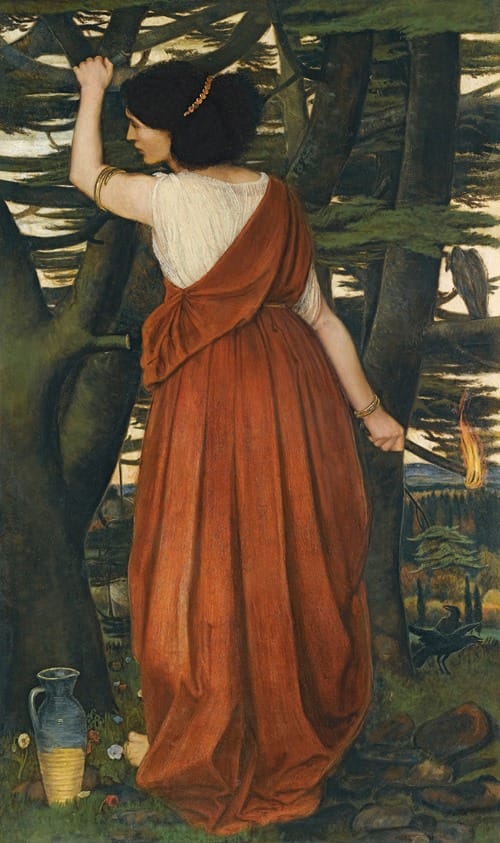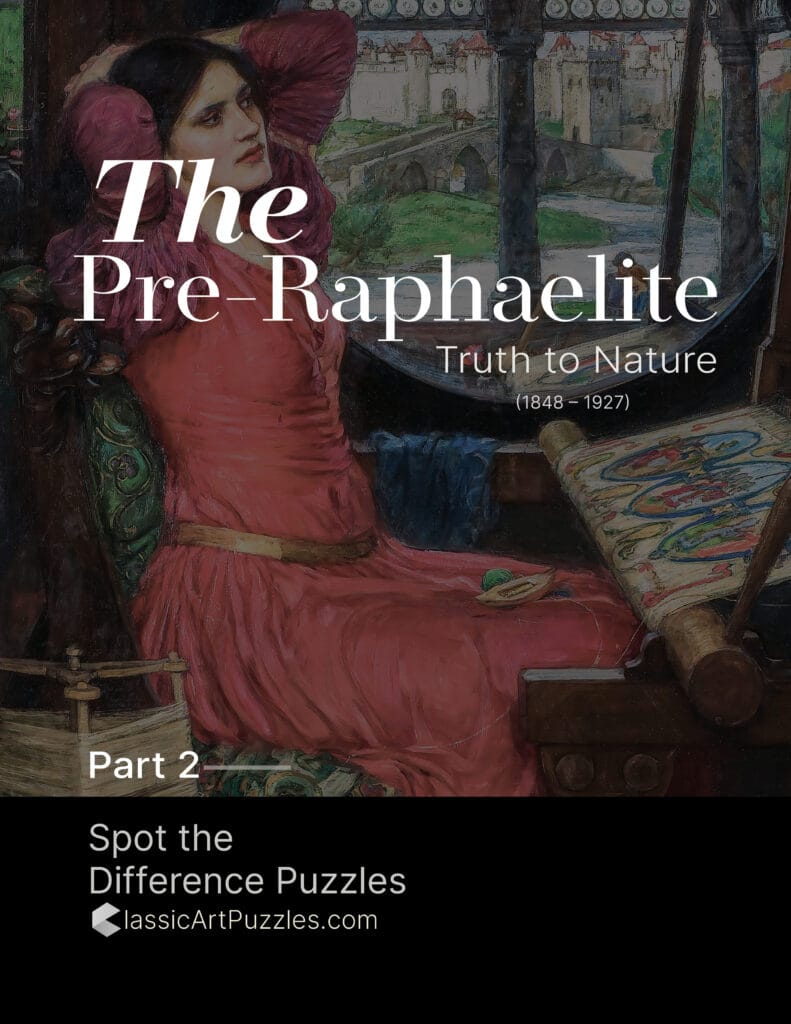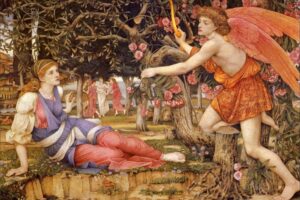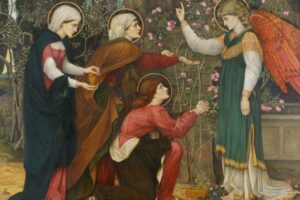Table of Contents
Overview
Painted in the 1870s, The Women of Sorrento Drawing in the Boats by John Roddam Spencer Stanhope (1829–1908) captures the strength and rhythm of communal life in southern Italy. The painting depicts a group of women laboring together to pull in fishing boats, their bodies united in effort against the backdrop of cliffs, a stone fortress, and the brilliant Mediterranean sea.
Stanhope, who spent much of his later life in Florence, found deep inspiration in Italian light and landscapes. This work reflects not only the beauty of Sorrento but also the dignity of labor, rendered with Pre-Raphaelite clarity and idealized form. The harmony of color and movement makes it both a study of collective energy and a celebration of rural Mediterranean culture.
It remains one of Stanhope’s most striking combinations of naturalism, symbolism, and social observation.
Artist
John Roddam Spencer Stanhope (1829–1908) was an English painter of the Pre-Raphaelite circle, closely associated with Edward Burne-Jones. His work often combines myth, allegory, and Italian influence, as he spent much of his later life in Florence. Known for luminous colors, spiritual intensity, and classical forms, Stanhope’s paintings are a bridge between Pre-Raphaelite naturalism and Symbolist vision.

The Story Behind the Painting
Sorrento as Inspiration
Sorrento, on the Amalfi Coast, was famed in the 19th century for its dramatic cliffs, olive groves, and seafaring culture. Stanhope translates these elements into an idealized setting where labor becomes poetic.
Labor and Community
The painting depicts women hauling fishing nets or boats — a daily task essential to survival. Yet, Stanhope elevates their work into a timeless image of unity, resilience, and dignity.
Victorian Fascination with Italy
For British artists and travelers, Italy represented both classical heritage and rustic authenticity. Here, Stanhope reflects Victorian admiration for Mediterranean life as both picturesque and morally instructive.
Composition and Subjects
The Line of Women
The figures move in rhythm, straining at the ropes, their colorful garments flowing with the effort. Their postures echo one another, creating a frieze-like procession that feels both classical and modern.
The Setting
The fortress walls, olive groves, and cliffs evoke permanence and tradition, anchoring the women’s action within a larger historical and natural frame.
The Rope as Symbol
The taut rope binding the women in labor becomes a metaphor for shared struggle and connection. It links them not only to the unseen boats but also to one another.
Art Style and Techniques
Pre-Raphaelite Detail
Every fold of cloth, strand of hair, and stone in the fortress is rendered with meticulous precision. Stanhope’s Pre-Raphaelite heritage shines in the clarity and saturated hues.
Mediterranean Light
The warm colors and luminous atmosphere reveal Stanhope’s deep engagement with Italy’s landscapes, a quality that distinguishes his later works.
Classical Influence
The women, though peasants in subject, are posed with a grace that recalls classical friezes — dignifying their labor as art worthy of epic treatment.
Featured in Our Collection
The Women of Sorrento Drawing in the Boats is included in our Pre-Raphaelite Spot-the-Difference Puzzle Flipbook P2. Its repeated figures, rich drapery, and architectural backdrop offer layers of detail that make for a compelling and challenging puzzle experience.
Strength in Harmony
A line of women pulls together, their strength bending into one rhythm, their world framed by cliffs and fortress walls. Stanhope’s Women of Sorrento is more than a picture of labor — it is a hymn to endurance, beauty, and shared humanity.
More About Artist

John Roddam Spencer Stanhope (January 20, 1829 – August 2, 1908) was an English artist associated with the second wave of the Pre-Raphaelite movement. Born into an aristocratic family in Cawthorne, Yorkshire, he was educated at Rugby School and Christ Church, Oxford. Despite his privileged background, Stanhope pursued a career in art, training under George Frederic Watts and traveling extensively, including trips to Italy and Asia Minor.
Artist Style and Movement
Stanhope’s work is typically classified within the later Pre-Raphaelite and Aesthetic movements of Victorian art. He worked across various media—oil, watercolor, fresco, tempera—and his subjects ranged from mythological and allegorical themes to biblical scenes and contemporary life. His early paintings featured highly original narrative compositions, which later evolved towards a more symbolic and aesthetic style influenced by broader Victorian artistic trends.
The Pre-Raphaelite Society continues to explore and share the legacy of this remarkable movement.
Artwork Profile
- Thoughts of the Past (1859), his first exhibited painting, depicting a contemplative woman by a window overlooking the Thames.
- The Shulamite: (Pastoral Scene with Lambs) (c. 1878), a serene and lyrical pastoral scene exemplifying his Pre-Raphaelite style.
- The Shulamite: (Bridal Procession) (c. 1882), depicting the procession with rich symbolism and ornate detail, continuing his Pre-Raphaelite themes.
- Penelope (1864), illustrating the faithful wife from Homeric legend in the detailed and expressive Pre-Raphaelite manner.
- Winnowing (c. 1880), portraying agricultural life with symbolic overtones typical of his narrative approach.
- Juliet and Her Nurse (c. 1860), a literary subject rich with emotional and dramatic qualities favored by Pre-Raphaelites.
- Why Seek ye the Living Among the Dead (1870–1899), a powerful biblical scene reflecting later symbolic and aesthetic tendencies.
- Love and the Maiden (1877), a romantic and allegorical composition showcasing his mature style.
- Charon and Psyche (1883), a mythological painting exploring themes of love and the afterlife.
- Pine Woods at Viareggio (1888), a landscape reflecting his time in Italy with delicate naturalism.
- The Gentle Music of a Bygone Day (1873), a nostalgic genre painting evoking memories and emotion.
- The Waters of Lethe by the Plains of Elysium (1880), a symbolic work referencing classical mythology and the afterlife.
John Roddam Spencer Stanhope’s artistic career reflects a rich engagement with the ideals of the Pre-Raphaelites, combined with a move towards aesthetic symbolism in later years. His work, characterized by technical skill and narrative depth, secured him a distinctive place in Victorian art history. Living much of his later life in Florence, he influenced subsequent artists including his niece Evelyn De Morgan, solidifying his legacy as a key figure bridging English Roman




